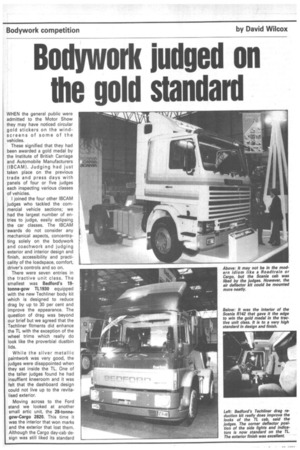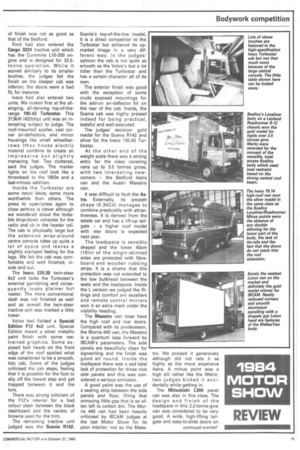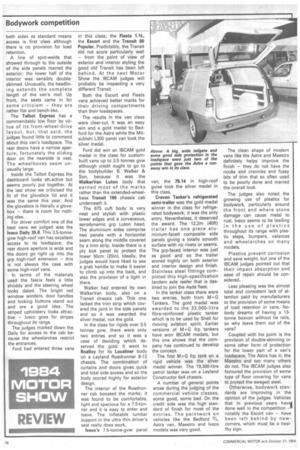Bodywork judged on the gold standard
Page 80

Page 81

Page 82

If you've noticed an error in this article please click here to report it so we can fix it.
WHEN the general public were admitted to the Motor Show they may have noticed circular gold stickers on the windscreens of some of the vehicles.
These signified that they had been awarded a gold medal by the Institute of British Carriage and Automobile Manufacturers (IBCAM). Judging had just taken place on the previous trade and press days with panels of four or five judges each inspecting various classes of vehicles.
I joined the four other IBCAM judges who tackled the commercial vehicle sections; we had the largest number of entries to judge, easily eclipsing the car classes. The IBCAM awards do not consider any mechanical aspects, concentrating solely on the bodywork and coachwork and judging exterior and interior design and finish, accessibility and practicality of the loadspace, comfort, driver's controls and so on.
There were seven entries in the tractive unit class. The smallest was Bedford's 19tonne-gcw TL1930 equipped with the new Techliner body kit which is designed to reduce drag by up to 30 per cent and improve the appearance. The question of drag was beyond our brief but we agreed that the Techliner fitments did enhance the TL with the exception of the wheel trims which really do look like the proverbial dustbin lids.
While the silver metallic paintwork was very good, the judges were disappointed when they sat inside the TL. One of the taller judges found he had insuffient kneeroom and it was felt that the dashboard design could not live up to the revitalised exterior.
Moving across to the Ford stand we looked at another small artic unit, the 28-tonnegcw-Cargo 2820. This time it was the interior that won marks and the exterior that lost them. Although the Cargo day-cab design was still liked its standard of finish was not as good as that of the Bedford.
Ford had also entered the Cargo 3224 tractive unit which has the Cummins L10-250 engine and is designed for 32.5tonne operation. While it scored similarly to its smaller brother, the judges felt the finish on the sleeper cab was inferior; the doors were a bad fit, for instance.
lveco had also entered two units. We looked first at the allsinging, all-dancing top-of-therange 190.42 Turbostar. This 313kW (420bhp) unit was an interesting subject to judge. The roof-mounted spoiler, vast corner air-deflectors, and mirror housings like small wheelbarrows (they house electric motors) combine to create an impressive but slightly menacing feel. Too cluttered, said the judges. The marker lights on the roof look like a throwback to the 1950s and a last-minute addition.
Inside the Turbostar are some novel ideas, some more worthwhile than others. The press to open/press again to close ashtray is clever although we wondered about the lockable drop-down consoles for the radio and cb in the header rail. The cab is physically large but the extensive wrap-around centre console takes up quite a lot of space and leaves a slightly cramped feeling for the legs. We felt the cab was comfortable and well finished, inside and out.
The Iveco 220.30 twin-steer 6x2 unit lacks the Turbostar's external garnishing and consequently looks plainer but neater. The more conventional dash was not finished as well and so overall the twin-steer tractive unit was marked a little lower.
Volvo had fielded a Special Edition F12 4x2 unit. Special Edition meant a silver metallic paint finish with some res trained graphics. Some ex posed bolt heads on the front edge of the roof spoiled what was considered to be a smooth, tidy cab. Some of the judges criticised the cab steps, feeling that it is possible for the foot to slip off the lowest step and get trapped between it and the tyre.
There was strong criticism of the F12's interior for a bad colour clash between the black dashboard and the variety of browns used for the trim.
The remaining tractive unit judged was the Scania R142. Scania's top-of-the-line model, it is a direct competitor to the Turbostar but achieved its upmarket image in a very different way. In the judges' opinion the cab is not quite as smooth as the Volvo's but a lot tidier than the Turbostar and has a certain character all of its own.
The exterior finish was good with the exception of some crude exposed mountings for the add-on air-deflector kit on the rear of the cab. Inside, the Scania cab was highly praised indeed for being practical, tasteful and well-executed.
The judges' decision: gold medal for the Scania R142 and silver for the lveco 190.42 Turbostar.
At the other end of the weight scale there was a strong entry for the class covering vans up to 3.5 tonnes gross, with two interesting newcomers — the Bedford Astra van and the Austin Maestro van.
It was difficult to fault the Astra. Externally, its smooth shape (0.34Cd) manages to combine practicality with attractiveness. It is derived from the estate car and has a lift-up tailgate — a higher roof model with rear doors is expected next year.
The loadspace is sensibly shaped and the lower 40cm (16in) of the single-skinned sides are protected with fibreboard and wooden rubbing strips. It is a shame that this protection was not extended to the low bulkhead between the seats and the loadspace. Inside the L version we judged the fittings and comfort are excellent and remote control mirrors won it an extra mark under the visibility heading.
The Maestro van does have the high roof and rear doors. Compared with its predecessor, the Morris 440 van, the Maestro is a quantum leap forward by IBCAM's parameters. The side panels are beautifully clean for signwriting and the finish was good all round. Inside the loadspace there was a sad total lack of protection for those nice side panels and this was considered a serious omission.
A good point was the use of a sealing strip between the side panels and floor, filling that annoying little gap that is so often left to collect dirt. The Morris 440 van had been heavily criticised by IBCAM judges at the last Motor Show for its poor interior; not so the Maes tro. We praised it generously although did not rate it as highly as the more expensive Astra. A minus point was a high sill rather like the Metro; two judges kicked it accidentally while getting in.
The Mitsubishi L300 panel van was also in this class. The design and finish of the loadspace in this 2.2-tonne-gvw van was considered to be very good. A wide, high-lifting tailgate and easy-to-slide doors on both sides as standard means access is first class although there is no provision for load retention.
A line of spot-welds that showed through to the outside of the side panels marred the exterior; the lower half of the interior was sensibly doubleskinned. Unusually, the headlining extends the complete length of the van's roof. Up front, the seats came in for some criticism — they are rather flat and bench-like.
The Talbot Express has a commendably low floor by virtue of its front-wheel-drive layout, but, that said, the judges found little to commend about this van's loadspace. The rear doors have a narrow aperture; fortunately the sliding door on the nearside is vast. The wheelboxes seem unusually large.
Inside the Talbot Express the dashboard looks atti active but seems poorly put together. At the last show we criticised the fit of the glovebox lid and it was the same this year. And the glovebox is literally a glovebox — there is room for nothing else.
For driver comfort one of the best vans we judged was the Iveco Daily 35.8. This 3.5-tonnegvw high-roof van has excellent access to its loadspace; the rear doors aperture is wide and the doors go right up into the grp high-roof extension — this is not always the case with some high-roof vans.
In terms of the materials used the fascia feels a little shoddy and the steering wheel looks dated. The bright red window winders, door handles and locking buttons stand out and are a good idea. The striped upholstery looks attractive — lveco goes for stripes throughout its range.
The judges marked down the Daily for access to the cab because the wheelarthes restrict the entrances.
Ford had entered three vans in this class; the Fiesta 1.1L, the Escort and the Transit 80 Popular. Predictably, the Transit did not score particularly well — from the point of view of exterior and interior styling the good old Transit has been left behind. At the next Motor Show the IBCAM judges will probably be inspecting a very different Transit.
Both the Escort and Fiesta vans achieved better marks for their driving compartments than their loadspaces.
The results in the van class were clear-cut. It was an easy win and a gold medal to Bedford for the Astra while the Mitsubishi L300 panel van took the silver medal.
Ford did win an IBCAM gold medal in the class for custombuilt vans up to 3.5 tonnes gvw although credit ought to go to the bodybuilder B. Walker & Son, because it was the WalkerVan Luton body that earned most of the marks rather than the extended-wheelbase Transit 190 chassis cab underneath it.
The 675 cuff body is very neat and stylish with plastic lower edges and a curvaceous, aerodynamic grp Luton head. The aluminium sides comprise two panels with a horizontal seam along the middle covered by a trim strip. Inside there is a ply kick panel to protect the lower 50cm (20in). Ideally, the judges would have liked to see a grab handle to make it easier to climb up into the back, and also the provision of a light in there.
Walker had entered its own WalkerVan body, also on a Transit chassis cab. This one lacked the trim strip which covered the joint in the side panels and so it was awarded the silver medal, not the gold.
In the class for rigids over 3.5 tonnes gvw, there were only two entries and so it was a case of deciding which deserved the gold. It went to Boalloy for its Localiner body on a Leyland Roadrunner 8-12 chassis. The combination of curtains and doors gives quick and total side access and so the body scored highly for exterior design.
The interior of the Roadrunner cab boosted the marks; it was found to be comfortable, light and spacious for a 7.5-tonner and it is easy to enter and leave. The inflatable lumbar support in the ultra thin driver's seat really does work.
lveco's 7.5-tonne-gvw panel van, the 79.14 in high-roof guise took the silver medal in this class.
Craven Tasker's refrigerated semi-trailer was the gold medal winner in the class for refrigerated bodywork; it was the only entry. Nevertheless, it deserved the award. The 12.2m (40ft) trailer has one piece aluminium-faced composite side panels giving a totally smooth surface with no rivets or seams. The grp-faced interior was just as good and so the trailer scored highly on both exterior and interior design and finish. Stainless steel fittings completed this high-specification tandem axle reefer that is destined to join the Asda fleet.
In the tanker class there were two entries, both from M+G Tankers. The gold medal was awarded to the 33,000-litre fibre-reinforced plastic tanker which is to be used by Shell for moving aviation spirit. Earlier versions of M+G frp tankers have won IBCAM medals, but this one shows that the company has continued to develop the concept.
The first M+G frp tank on a rigid vehicle was the silver medal winner. The 19,300-litre petrol tanker was on a Leyland Constructor 6x4 chassis.
A number of general points arose during the judging of the commercial vehicle classes, some good, some bad. On the credit side was the high standard of finish for most of the entries. The paintwork on vehicles like the Bedford TL, Astra van, Maestro and Iveco models was very good. The clean shape of modern vans like the Astra and Maestro definitely helps improve the finish — they do not have the nooks and crannies and fussy bits of trim that so often used to be poorly done and marred the overall look.
The judges also noted the growing use of plastics for bodywork, particularly around the front end where stone damage can cause metal to rust. Iveco seems to be leading in the use of plastics throughout its range with plastic steps, bumpers, valances and wheelarches on many models.
Plastics prevent corrosion and save weight, but one of the IBCAM judges pointed out that their impact absorption and ease of repair should be considered.
Less pleasing was the almost total and consistent lack of attention paid by manufacturers to the provision of some means of load retention in vans. Nobody dreams of having a 13tonne boxvan without tie rails, so why leave them out of the vans?
Coupled with his point is the provision of double-skinning or some other form of protection for the lower part of a van's loadspace. The Astra has it; the Maestro and too many others do not. The IBCAM judges also favoured the provision of some type of floor covering for vans to protect the swaged steel.
Otherwise, bodywork standards are improving in the opinion of the judges. Vehicles that in previous years have/ done well in the competition —14 notably the Escort van — have been left behind by newcomers, which must be a healthy sign.


















































































































